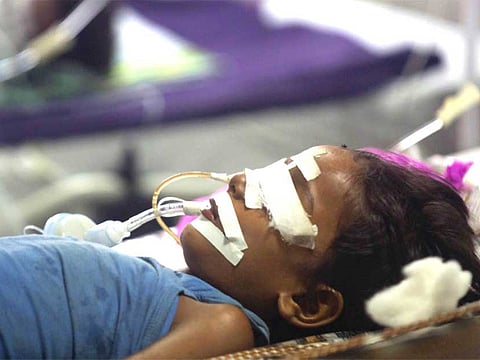Apathy leads to child deaths in India
While Modi’s government has cleared the National Health Policy 2017, the budget never even came close to achieving its goals

After the Gorakhpur hospital tragedy in India last month, lack of medical care and oxygen supply have come to haunt hospitals in Jamshedpur and Farukhabad as well. Two weeks after infant deaths in Gorakhpur, 52 children died in Jamshedpur due to pre-mature births. The chief reason was malnutrition. Forty-nine infants died in Farukhabad because of lack of oxygen supply. The chief medical officer and the district magistrate have been removed.
Last month, 63 children suffering from encephalitis lost their lives in the state-run BRD hospital in Gorakhpur, Uttar Pradesh. They died due to lack of oxygen and within a span of seven days. India’s ruling Bharatiya Janata Party (BJP) president and Prime Minister Narendra Modi’s close aide, Amit Shah, said such incidents have occurred in the past, making a mockery of the deaths and standing by Yogi Adityanath — the man whom he chose as UP Chief Minister.
The Gorakhpur probe report found the hospital and the oxygen supplier responsible for the deaths. Criminal proceedings were initiated against four officials, the doctor who was in-charge of the encephalitis ward and the principal of BRD Medical College were arrested. The same hospital reported more deaths earlier this month, even after appointing a new principal. Thirty-five children died within a span of 48 hours, taking the toll to 1,304 for this year alone.
What the Gorakhpur probe did not find is the situation that led to the tragedy. It concealed repeated reminders for payment, from the oxygen suppliers, to the UP Health Ministry for six months and in turn absolving the health minster and his boss. The report and arrests seem to make a travesty in the face of recurring deaths in Gorakhpur, Jamshedpur and Farukhabad.
Adityanath denied it was due to infections and lack of oxygen supply. Squalor and open defecation, he claimed, were behind the deaths, admitting that his own parliamentary constituency of Gorakhpur was in a shambles. Ironically, he has been a member of parliament from Gorakhpur for the last 20 long years.
Among a barrage of criticisms, Nobel Peace Prize winner Kailash Satyarthi and Oscar award winner Resul Pookutty have called this a massacre and a blot on the Indian conscience.
Gorakhpur has a notorious health-care history. According to one report, 25,000 children under the age of eight years have died due to Japanese Encephalitis (JE) and Advanced Encephalitis Syndrome (AES) since 2008; out of which, 9,950 have died at the Gorakhpur Medical College, under Adityanath’s watch.
Child and infant deaths in Gorakhpur, Jamshedpur and Farukhabad are a macabre reflection of India’s failed health-care system and the country’s appalling statistics on neonatal care and health-care spending. Consider this. Every year, 1.08 million children die in India and that is almost half of Dubai’s population. Nearly two children under the age of five died every minute in India in 2015. And in the same year, 321 children died every day of diarrhoea alone.
The most common reasons were neonatal, pneumonia, diarrhoea, measles and injuries, symptoms and diseases that were preventable. States like Assam, Madhya Pradesh and UP rank below Ghana in under-five mortality rate. India has an under-five mortality rate of 43:1,000 and ranks at the top among Brics (Brazil, Russia, India, China and South Africa) countries. India’s health-care spend is 1.18 per cent of its gross domestic product, compared to the global average of 6 per cent.
According to a Unicef report, other countries that had lost children under the age of five were Myanmar (3,273 deaths), Kenya (5,442 deaths) and Pakistan (39,484 deaths). Ironically, all three countries have a much lower per capita income than India. Out of 188 countries assessed, in a global analysis, on sustainable development goal in health performance, India ranked 143 and was way behind countries like Sri Lanka (79), China (92), and even war-torn Syria (117) and Iraq (128).
Dr Vikram Patel from the London School of Hygiene and Tropical Medicine argues that India continues to be one of the worst-performing countries in health because its political and medical classes have persistently ignored public health principles.
The ‘State of The World’s Children’ report for 2016 notes countries such as Nigeria and India are apathetic to reducing child mortality despite leading on the economic growth front. It looks from India’s health-care history that economic indicators are not a barometer for health indicators or for that matter an assurance for improved child survival.
While Modi’s government has cleared the National Health Policy 2017, that promised to increase the health-care expenditure from 1.18 per cent to 2.5 per cent of GDP, guaranteeing health care to all and particularly the underprivileged, the budget of 2017-18 never even came close to keeping that promise.
In the meanwhile, Adityanath has vowed to punish the guilty after absolving himself of the contamination and filth that he has nurtured in his constituency for 20 years.
Percy Fernandez is the chairperson of School of Media & Communication at the Manipal University in Dubai.
Sign up for the Daily Briefing
Get the latest news and updates straight to your inbox



